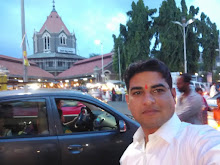
Phad Paintings are the folk paintings of western India, especially Rajasthan. Phad paintings, speaking in general terms, are large paintings on cloth which commemorate the heroic deeds of a hero. The smaller version of Phad paintings is called pahadkye.
The origin of the phad paintings is not clearly known because as a custom the phad were destroyed by submerging in a lake near Pushkar. This is the reason the earliest specimens of phad paintings are not available. The oldest phad paintings available belong to late 19th century or early 20th century.
The main theme of this painting style was to illustrate the heroics of Goga Chauhan, Prithviraj Chauhan, Amar Singh Rathore and Tejaji. However, now in the present times, old heroes have been replaced by new ones like Papuji and Narayandevi. Phadkye, the smaller version of phad paintings primarily depict the stories of Ram Krishnadala, Bhainsasura and Ramdev.
The heroes depicted in the phad paintings are those humans who have attained the divine status because of their valor and achievements in numerous battles fought for the honor and defence of motherland.
Phad paintings are painted by people of special cast- Chippa also called Joshis. These paintings have attained a sacred stature and before the beginning the drawing certain rituals and ceremonies are observed. An interesting fact of the making of phad paintings is that no work is done on phads during the monsoon season. This is done with the belief that the folk deities remain asleep during this season.
The colors used in these paintings are sequentially saffron, green, brown, vermillion, sky blue and black. Traditionally, the colors used are derived from vegetables and minerals. Though, in present times, synthetic colors have also gained prominence.
One more interesting tradition about the phad painting is that the painter does not paint the eyes of the painting until he hands that over to bhopa (fellow from Bhopa caste, who specialize is singing different folk tales). At the time of handing over cloth painting to him, painter gives the final touch to the painting by drawing the eyes of the character concerned. At this time he also adds the name of the bhopa and the date on the painting. Bhopas in a group of two or three sing the tales illustrated in the phads and a musical tribute is paid to the hero.
For their unique appeal, Phads have become commercial commodity, in the present times.
For more information please visit http://www.ethnicpaintings.com/
The origin of the phad paintings is not clearly known because as a custom the phad were destroyed by submerging in a lake near Pushkar. This is the reason the earliest specimens of phad paintings are not available. The oldest phad paintings available belong to late 19th century or early 20th century.
The main theme of this painting style was to illustrate the heroics of Goga Chauhan, Prithviraj Chauhan, Amar Singh Rathore and Tejaji. However, now in the present times, old heroes have been replaced by new ones like Papuji and Narayandevi. Phadkye, the smaller version of phad paintings primarily depict the stories of Ram Krishnadala, Bhainsasura and Ramdev.
The heroes depicted in the phad paintings are those humans who have attained the divine status because of their valor and achievements in numerous battles fought for the honor and defence of motherland.
Phad paintings are painted by people of special cast- Chippa also called Joshis. These paintings have attained a sacred stature and before the beginning the drawing certain rituals and ceremonies are observed. An interesting fact of the making of phad paintings is that no work is done on phads during the monsoon season. This is done with the belief that the folk deities remain asleep during this season.
The colors used in these paintings are sequentially saffron, green, brown, vermillion, sky blue and black. Traditionally, the colors used are derived from vegetables and minerals. Though, in present times, synthetic colors have also gained prominence.
One more interesting tradition about the phad painting is that the painter does not paint the eyes of the painting until he hands that over to bhopa (fellow from Bhopa caste, who specialize is singing different folk tales). At the time of handing over cloth painting to him, painter gives the final touch to the painting by drawing the eyes of the character concerned. At this time he also adds the name of the bhopa and the date on the painting. Bhopas in a group of two or three sing the tales illustrated in the phads and a musical tribute is paid to the hero.
For their unique appeal, Phads have become commercial commodity, in the present times.
For more information please visit http://www.ethnicpaintings.com/



No comments:
Post a Comment